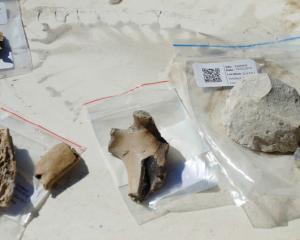University of Otago researchers have proved there really is life in maars.
And a recently discovered "treasure trove" of thousands of fossilised flowers, fruits, mummified leaves, insects and other ancient specimens found in Otago-Southland is likely to help revolutionise the understanding of the origins of New Zealand's modern flora and fauna.
Otago University geologist Associate Prof Daphne Lee is "absolutely over the moon" to have gained a $767,000 grant, over three years, from the prestigious Marsden Fund, to study the fossils, and to help collect many more.
A maar is a shallow, circular crater of volcanic origin, which is often filled with water.
Otago researchers have found fossils in many contexts, including preserved in fine lake sediments, or in amber, including in maar lakes, oil shale lakes, and swamp and river deposits.
All the finds have been made on private land, including near Middlemarch, and in the Nevis Valley, near Cromwell, and at Landslip Hill, near Gore.
A paleobotanist, Prof Lee is one of 26 Otago University principal investigators to have gained grants totalling $17.8 million in the latest annual Marsden funding round.
Her research project is titled "Life in and beyond maars" and raises the possibility of a "revolution in understanding" of large changes in the environment and in plant and animal life that occurred 23 million to 10 million years ago, during the Miocene period.
The origins and history of New Zealand terrestrial biota - all plant and animal life - were "complex, controversial and poorly understood".
"These fossils provide a remarkably comprehensive window into the world from which the distinctive modern day biota originated," she said.
The "exquisitely well-preserved" Miocene fossils and analysis of ancient sediments would enable researchers to "reconstruct whole Miocene ecosystems".
Dr Dallas Mildenhall, from GNS Science, Lower Hutt, is co-principal researcher in the project, which also involves Otago geology research fellow Dr Jon Lindqvist and Dunedin paleobotanist Jennifer Bannister, as well as other colleagues in Australia and Germany.
Finding and analysing the ancient fossils was "always exciting", Prof Lee said.
"You can't predict what you're going to find," she said.
"It's been buried for 10 to 20 million years and we're the first people to ever see it.
"Everyone wants to travel back in time but we're the only ones who can actually do it," she joked.
The "stunning array" of fossil finds, including flowers containing pollen, fruits and seeds, as well as microscopic algae had come from the recently-found sites, mainly over the past three years.
Many of these types of organism were rarely preserved as fossils and hardly ever with such detail.
Otago's climate 23 million years ago was likely to have been warmer than it is today, perhaps similar to temperatures in southern Queensland, about 20degC throughout the year, researchers said.
• Early in their investigation, researchers have already achieved a series of fossil "firsts".
Three months ago they made the first confirmed discovery of a fossilised insect in kauri gum - a tiny mite.
Discovered at a lakesite in 2008 were two fossil orchids, which are the only known orchid fossil specimens throughout the world.
A 15cm-long fossilised fish found about five years ago by Prof Lee is, at 23 million years old, the world's oldest known fossilised galaxiid fish.









